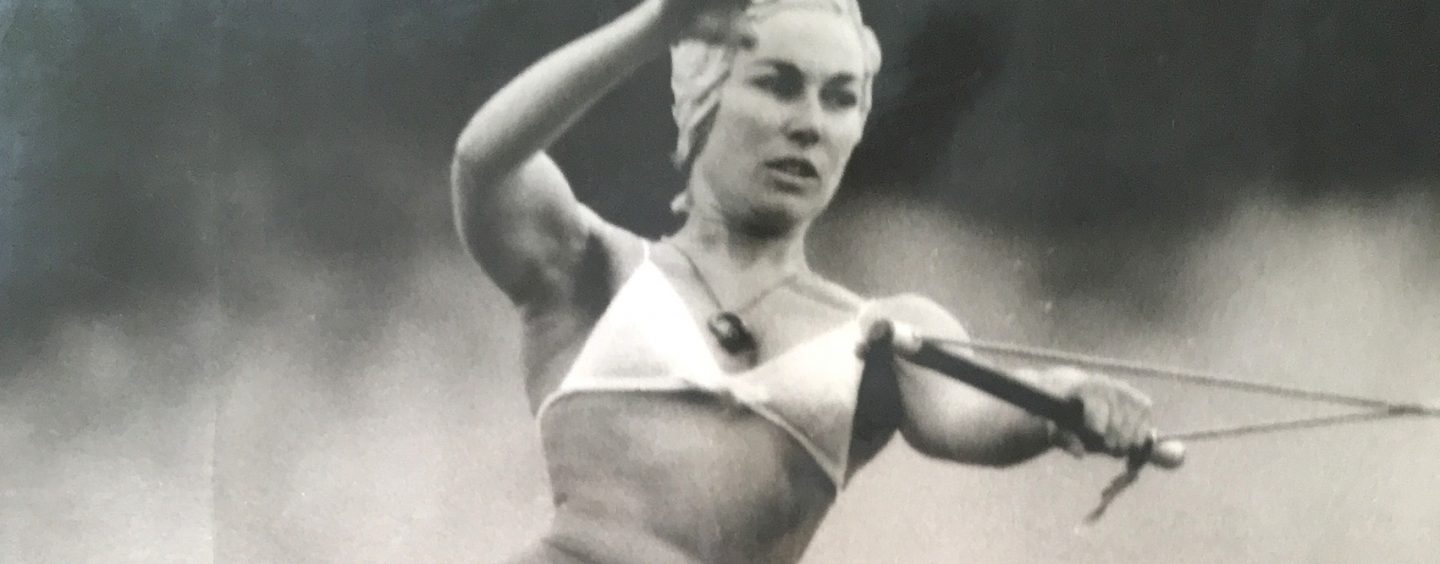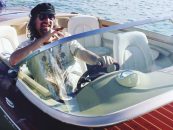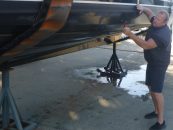The 100-year history of the first settlers along the Nerang River was focused around the development of cotton and sugar plantations at the river in Carrara, Bundall, and Benowa. This area was not commonly known for its water skiing history that began in 1957, when the Surfers Paradise Ski Gardens owned by Keith Williams opened along the Nerang River.
By the late 1960s, the river was already home to many people making a living from recreational boating and training others to water ski. However, a little known part of water ski history along the river is another water ski school established in 1968 next to the Ski Gardens. It was built by Neville Parker and his wife, Shirley, who were some of the original suburb residents who answered to the beckoning of Nerang River.
Neville was a self-taught water skier. He learned to ski in Old Petrie Town on Lake Kurwongbah, north of Brisbane. “Some people liked to play golf; we preferred to water ski. It was very much a family affair. The whole family was involved in water skiing. My wife, daughter Anne, and my sons Lindsey and Kingsley became accomplished water skiers. Lindsey became a junior Queensland champion, and Kingsley was a well-regarded jump- and trick-skier.” Neville was one of the original founders of Queensland Water Skiing Association.
On a trip to the Gold Coast to watch his son, Lindsey, compete in the Queensland Championships at the Surfers Paradise Ski Gardens, Neville stumbled across a neighbouring property for sale. He purchased the land, with the intent of building a waterski holiday home. Eventually, the family moved from Brisbane to settle at the property. What started as a family hobby – water skiing – evolved into the family business, the Carrara Water Ski School.
Back then, while most other businesses were referring to the area as Surfers Paradise, Neville chose to use “Carrara” as it was the actual name of the suburb where the ski school was. Neville is credited as the first local to use the suburb name Carrara in his business. A local police sergeant, Herb Boyd, pointed out to him that the area is technically not Surfers Paradise, as most businesses referred to, and that it was actually Carrara. According to Neville, one of the benefits of using the name “Carrara” was that business names that started with C were still at the beginning of the water ski section of the Yellow Pages. Besides, surf and high-rises of Surfers Paradise were a long way from the ski school.
The location and the decision to use “Carrara” in the name must have paid off, as Neville’s hobby-business became busier and more popular. “In the early years, the ski school was only open for business during the summer months. Through word of mouth, the numbers increased, and it didn’t take long for the ski school to be open all year round.”
Over the years, Neville taught many people to water ski – couples in their 70s, a 19-year old blind girl, a leg amputee, students from local schools, Sea World ski show performers, all of his grand children, and even their own family German Shepherd, Rex. Many celebrities also came to the ski school to learn to ski – the members of the rock band AC/DC, Kylie and Danni Minogue, Joe Cocker, Debra Byrne, ice-skating champions Torvill and Dean, Lionel Richie, and the Prince of Dubai.
In the 35 years the ski school was open for business, it won several awards and was known as one of the best places to learn the sport throughout Australia. It was one of the popular places on the Gold Coast to visit for holidaymakers and locals alike. So popular was the destination that several local and international TV shows were filmed on-site, as were movies and commercials. These included familiar brands such as Skippy, Pepsi, Juicy Fruit (featuring Lindsey).
The feature movie, Goodbye Paradise, starring Ray Barrett was also filmed there. Neville fondly remembers lying on the floor of the speedboat, out of
sight of the cameras, looking up at Ray Barrett, while giving him instructions on how to drive the boat.
The ski school developed an efficient method of teaching. The boat has a learner’s bar on the side [pictured], which allowed the teacher to talk directly to the ski student. This technique allowed the ski instructor to teach someone to ski in under an hour.
Neville’s expertise stretched further than teaching at Carrara. He was summoned more than once to Papua New Guinea to layout a slalom course for an important international competition. During the Japanese-led tourist boom in the 80s and 90s, Neville engaged the services of Japanese-speaking instructors to cope with the influx of customers all wanting to learn how to water ski. The business also evolved to include a jet ski hire, and the establishment of the first water taxi service on the river.
The history of the Nerang River goes beyond modern-day infrastructure and developments – each generation having their own stories to tell about their own river experience. Nerang River has been a water ski paradise for many decades. Many residents in the area raised their families in the world of water ski and other boating activities. The Parkers’ story is one that celebrates boating and water skiing, and the river life from the 50s to the early 2000s on the Gold Coast.
Neville and Shirley Parker eventually retired from the business around 2003. The property was sold to the Morris Family of Sirromet Wine fame, who have built homes for their extended family on the sprawling properties along the river. Affectionately, the Morris’s still call the place “The Ski School”.
SNIPPETS OF WATER SKI HISTORY
For many years, it was generally acknowledged that the late Fred Waller of the USA was the founder of water skiing in 1924. But in late 1965, this distinction was challenged. Facts now reveal that another American, Ralph Samuelson, transferred the principles of snow skiing to water, and in 1922 skimmed across a nearby lake firstly on barrel staves, then on snow skis, and finally, on eight-foot long pine boards (which he had curved at the tips by steaming in boiling water).
The thrills of water skiing were first experienced in Europe in 1934 and in Australia in 1936. However, World War II (WWII) temporarily halted its progress. Following the war, this exciting new sport bounded into popularity all over the world. Clubs and organisations were established, and every type of waterway seemed to buzz with boats towing men and women, boys and girls, people of all ages, from every walk of life.
Competition, being an essential part of progress, entered into water skiing. In 1946, the first European Championships were held based on the rules that were improvised almost “as they went along”. The first world Water Ski Championships were held in France at Juan Les Pins in 1949.
In 1936, Karl Atkinson of Darwin introduced water skiing to Australia. The sport apparently “died”. However, after WWII, it experienced a revival for which Jack Murray of Sydney would receive credit. In the post-war years, water skiing in Australia advanced slowly at first. 1950 saw the first organised tournament, and the following year the first Australian Water Ski Championships were held.
In 1953, Australia sent the first representatives, Betty Leighton and John Kumm, to compete at the 3rd World Water Ski Championships in Toronto, Canada. When Surfers Paradise (Australia) hosted the 1965 World Championships, the Australian team was placed 3rd among twenty competing nations.
Dick Pope, the developer of the once internationally renowned Cypress Gardens Water Ski Park, along with his brother, Malcolm, invented ski jumping, undoubtedly the most thrilling event in tournament skiing and an essential part of every ski show. The miracle of barefoot skiing was introduced to the world by Dick Pope Jr many years ago. Even today, it is still considered a most amazing human feat. Over the years, barefoot skiing has progressed to include barefoot skiing backwards as well as forwards, beach, deep-water and step-off starts, and spins on barefoot; there is even topside tandem on barefoot.
The late Doug Laversha from Victoria takes the bow for introducing Ski Kite Flying. Doug was the first man to become airborne on skis and perfected this radical departure from usual water skiing in 1953, although no person is committed enough to practice this extension of the sport today.
In Queensland, water skiing was intriduced in 1950 by Bruce Hope. In 1955, Bruce taught Keith Williams to water ski at his school along the shores of Main Beach. In 1956, Keith went on to open the Surfers Paradise Ski Gardens. That same year, he won the Queensland Trick-Skiing Championship, and the Australian Championship in 1959.
By Andy Kancachian
——————
A SPEED LIMIT OF 6 KNOTS:
• within 30m of boats anchored, moored to the shore or around a jetty, wharf, pontoon or boat ramp
• within 30m of persons in the water
• within 60m of persons in the water when operating a personal watercraft in boat harbours and marinas.
Even at slow speeds, your boat will create a wash. Look behind at your wash, and be aware of the impact this can have on other boats and people in the water or the shore.
Water skiing on the Nerang River is only allowed in the following areas:
• between Bosun Parade, Ashmore and Ross Street, Carrara between 7am and 7pm;
• between Ross Street, Carrara and Hoy Street, Broadbeach Waters between 7am and 7pm; and,
• between Capri Bridge and Bundall Road Bridge, Sorrento between 8am and 4pm.
JOIN A WATER SKI CLUB:
The Gold Coast waterways offer good locations for the water skiing, despite a number of restrictions imposed in certain areas (speed limits, daily time frame, etc.). Many locals are involved in recreational and competitive water skiing here and around the world.
For water skiing safety rules in Queensland: www.msq.qld.gov.au/Safety/Water-skiing
For waterskiing clubs in SEQ: www.facebook.com/GCWSCOfficial www.facebook.com/groups/barefootsthqld www.ozskiresort.com www.uqski.com www.tweedriverwaterskiclub.com



























